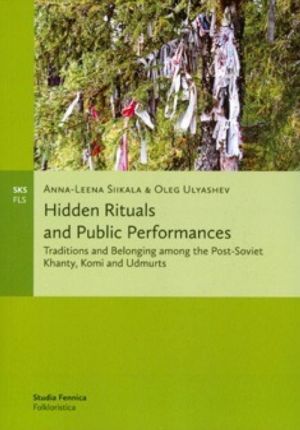Miksi shamaanit ovat yhä aktiivisia? Mitä ovat komien folklorekollektiivit? Miksi udmurttien riittejä esitetään kulttuurifestivaaleilla? Anna-Leena Siikala ja Oleg Ulyashev pyrkivät vastaamaan näihin kysymyksiin oivaltavassa etnografisessa tutkimuksessaan analysoimalla uskonnollisten perinteiden, myyttien ja laulujen uudelleen luomista sekä julkisissa että salaisissa tilanteissa. Heidän työnsä perustuu pitkäaikaiseen kenttätyöhön pohjoisen Obin alueella luoteisessa Siperiassa sekä Komin ja Udmurtian tasavalloissa. He valottavat miten tämän päivän monikulttuurisella Venäjällä suositaan ja muunnetaan erilaisia traditioita. Siikala ja Ulyashev tarkastelevat rituaaleja, lauluja ja festivaaleja, jotka korostavat ryhmien erityisyyttä ja luovat samalla kuulumisen tunteen, ja tulkitsevat niitä alueen, valtion ja kulttuuripolitiikan näkökulmista. Havaintojen vertailu osoittaa, että etnisen kulttuurin esittämismahdollisuudet vaihtelevat historialtaan ja hallinnoltaan erilaisilla alueilla. Paikallisten tahojen ja viranomaisten dialogi määrittää tätä variaatiota.
Tuoteryhmä: Suomalaiset kirjat > Kaunokirjallisuus. Kirjallisuustiede. Kielitiede > Kirjallisuustiede > Yleinen kirjallisuudenhistoria > Kansanrunouden historia ja tutkimus
Tuotesarja: Studia Fennica Folkloristica 19
Why are Khanty shamans still active? What are the folklore collectives of Komi? Why are the rituals of Udmurts performed at cultural festivals? In their insightful ethnographic study Anna-Leena Siikala and Oleg Ulyashev attempt to answer such questions by analysing the recreation of religious traditions, myths, and songs in public and private performances. Their work is based on long term fieldwork undertaken during the 1990s and 2000s in three different places, the Northern Ob region in North West Siberia and in the Komi and Udmurt Republics. It sheds light on how different traditions are favoured and transformed in multicultural Russia today. Siikala and Ulyashev examine rituals, songs, and festivals that emphasize specificity and create feelings of belonging between members of families, kin groups, villages, ethnic groups, and nations, and interpret them from a perspective of area, state, and cultural policies. A closer look at post-Soviet Khanty, Komi and Udmurts shows that opportunities to perform ethnic culture vary significantly among Russian minorities with different histories and administrative organisation. Within this variation the dialogue between local and administrative needs is decisive.
Why are Khanty shamans still active? What are the folklore collectives of Komi? Why are the rituals of Udmurts performed at cultural festivals? In their insightful ethnographic study Anna-Leena Siikala and Oleg Ulyashev attempt to answer such questions by analysing the recreation of religious traditions, myths, and songs in public and private performances. Their work is based on long term fieldwork undertaken during the 1990s and 2000s in three different places, the Northern Ob region in North West Siberia and in the Komi and Udmurt Republics. It sheds light on how different traditions are favoured and transformed in multicultural Russia today. Siikala and Ulyashev examine rituals, songs, and festivals that emphasize specificity and create feelings of belonging between members of families, kin groups, villages, ethnic groups, and nations, and interpret them from a perspective of area, state, and cultural policies. A closer look at post-Soviet Khanty, Komi and Udmurts shows that opportunities to perform ethnic culture vary significantly among Russian minorities with different histories and administrative organisation. Within this variation the dialogue between local and administrative needs is decisive.













